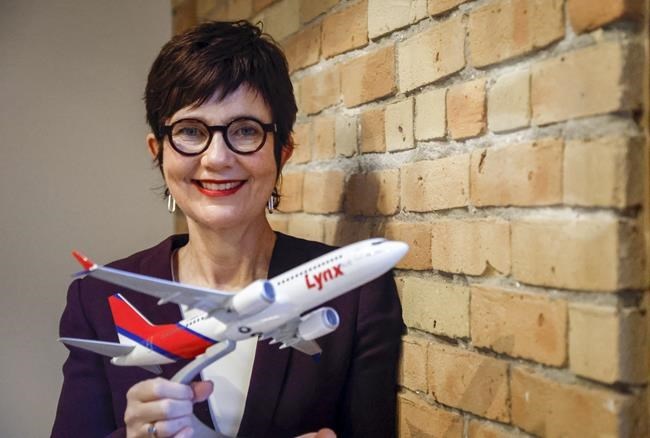Australian Merren McArthur first touched down in Canada in the mid-1980s for a ski holiday that turned into a two-month stay in the Rockies.
“I landed in Calgary and the pilot said it was -40 C. And I was like, ‘Whoa, I didn't know that humans could survive in that temperature,’” McArthur recalls.
“I walked into the Banff Springs Hotel and asked them if they had any jobs. I became their first female doorman."
She loved the skiing. “But I remember being introduced to Caesar cocktails, and I really liked them."
Now McArthur's back as CEO of Lynx Air, enticed by the mountainous task of getting an upstart budget carrier off the ground amid intense low-cost competition and the COVID-19 pandemic.
Several ultra-low-cost carriers (ULCCs) have been beefing up since the summer in preparation for a clash with Air Canada and WestJet Airlines Ltd. — and with each other — particularly for domestic flights and sun destinations.
Flair Airlines was down to one aircraft in April. It now has a dozen 737s, with eight more coming by the end of June as the Edmonton-based airline adds routes from Victoria to St. John's, N.L.
Meanwhile, WestJet budget subsidiary Swoop continues to expand, unveiling nine new routes out of Edmonton in November.
“It is going to be a price war,” said aviation expert and McGill University lecturer John Gradek.
"It's a harbinger of what's going to happen this summer with the continuous battle between Flair and Lynx to basically get the price advantage in the marketplace. And Air Canada and WestJet are going to get caught in the crossfire," Gradek said.
McArthur says “it will be competitive,” but that she sees pent-up demand in Canada, where ULCCs claim only about 12 per cent of the market compared with more than 40 per cent in Europe.
“We're not really about targeting or taking share away from our competitors, we're actually about enticing more people to fly and growing the market," she says.
Lynx, formerly known as Enerjet, plans to make its first flight from Calgary to Vancouver on April 7. By May it aims to operate 76 flights per week along seven routes servicing Vancouver, Kelowna, B.C., Calgary, Winnipeg and Toronto. The company expects more routes will be added this summer.
For the moment, flight cancellations define the sector. In the last three weeks alone Air Canada, WestJet, Transat, Sunwing, Flair and Swoop have scrapped more than 5,300 flights in February alone, or 14.5 per cent of their collective trips, according to figures from airline data company Cirium.
Even if travel restrictions ease and demand rebounds, other hurdles remain.
A shortage of staff, particularly pilots, continues to hamper the industry, though Lynx hopes to hire 450 employees this year, the majority in Calgary. North America will face a shortage of 12,000 pilots by 2023, according to projections from consulting firm Oliver Wyman.
Shifting travel patterns have also seen more Canadians make leisure travel decisions at the last minute, while others opt for road trips instead of air.
“People are finding it difficult to plan months in advance with changing COVID restrictions and developments,” said David Huttner, a London-based expert in low-cost-carriers, which offer bare-bones discount fares and charge extra for services such as checked bags and cancellations.
“The travel habits change, especially on shorter routes. Someone going Montreal-Ottawa now might be more likely to drive in their own car."
But while the pandemic saw billions of dollars in revenue go up in smoke over the past 20 months, it also burned down barriers to entry for new airlines.
Plummeting demand for aircraft meant carriers could access them more quickly and cheaply. And greater availability of airport slots has given companies leverage when striking deals with airport authorities.
McArthur — like Flair CEO Stephen Jones and WestJet chief operating officer Diederik Pen — cut her teeth in the Australia-New Zealand aviation market, an ideal training ground for Canadian airline executives.
Both Australia and Canada are massive countries with diffuse populations dependent on air travel to span the great distances between cities. Both have a long-standing flag carrier — Qantas and Air Canada respectively — that dominates the market. Both have hosted few independent low-cost carriers, with Canada a noted graveyard for budget airlines — six foundered here between 1995 and 2015: Greyhound Air, Roots Air, Air Canada's Zip, Jetsgo, Zoom Airlines and Canjet.
McArthur is the second woman to head a national commercial airline in Canada, following Annick Guérard — who became the No. 1 at Transat A.T. last May, less than two weeks before McArthur began her tenure.
She worked as a lawyer for two decades, eventually landing as general counsel to low-cost airline Virgin Blue — soon to become Virgin Australia — in 2008.
She started as CEO of Virgin Australia Regional Airlines in 2013, returning it to profit within three years by focusing on charter flights for mining and resource companies, and continued to juggle that job after becoming chief executive of Virgin Australia Cargo.
Before taking a career break just before the pandemic struck, McArthur shifted to CEO of Virgin Australia's low-cost Tigerair Australia in 2018, where she assembled a management team that achieved gender parity.
“I perhaps have a natural tendency to embrace diversity, because I do think that creativity and innovation is driven by people being able to bounce different ideas around the table," she says.
This report by The Canadian Press was first published Jan. 30, 2022.
Companies in this story: (TSX:AC, TSX:TRZ)
Christopher Reynolds, The Canadian Press




